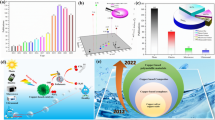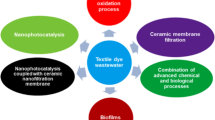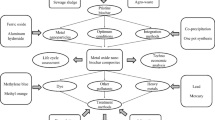Abstract
In this study, electro-Fenton (EF) process was used for the decolorization and mineralization of Basic Black 3 (BB3) (a popular textile dye), and the treatment performance of carbon fiber was investigated as a different cathode material to in situ electro-generated H2O2. Total organic carbon (TOC) and color removal were selected as performance indicators of the process. For this purpose, some operational parameters such as pH, Fe2+ concentration, current, oxygen flow rate, and supporting electrolyte concentration were optimized, and the best treatment conditions were found as 3, 100 mg/L, 200 mA, 0.5 L/min, and 50 mM, respectively. At these optimum conditions, complete color removal and 39.1 % TOC removals were achieved in 100 min of electrolysis time. The results obtained from the study indicate that EF process can mineralize and decolorize BB3, therefore, it can be selected as a pre-treatment technology before different conventional treatment methods for reducing toxicity and enhancing the biodegradability of wastewater. According to the results, carbon fiber cathode may offer a wastewater treatment alternative by electrochemical technologies.










Similar content being viewed by others
Abbreviations
- Ao :
-
Absorbance value (nm) at initial
- AOPs:
-
Advanced oxidation processes
- APHA:
-
American Public Health Association
- At :
-
Absorbance value (nm) at time “t”
- BB3:
-
Basic Black 3
- CI:
-
Color index
- COD:
-
Chemical oxygen demand (mg/L)
- DC:
-
Direct current
- EF:
-
Electro-Fenton
- I :
-
Applied current (mA)
- OH*:
-
Hydroxyl radical
- SEC:
-
Specific energy consumption (kWh m−3)
- SEM:
-
Scanning electron microscopy
- t:
-
Time (min)
- TOC:
-
Total organic carbon (mg/L)
- V :
-
Potential (V)
- λmax :
-
Wavelength at maximum absorbance (nm)
- η:
-
Efficiency of removal (%)
References
Anirudhan TS, Ramachandran M (2015) Adsorptive removal of basic dyes from aqueous solutions by surfactant modified bentonite clay (organoclay): kinetic and competitive adsorption isotherm. Process Safe Environ Prot 95:215–225. doi:10.1016/j.psep.2015.03.003
Apha A (1998) Standard methods for the examination of water and wastewater, 20th edn. American Public Health Association, Washington DC
Babuponnusami A, Muthukumar K (2012) Advanced oxidation of phenol: a comparison between Fenton, electro-Fenton, sono-electro-Fenton and photo-electro-Fenton processes. Chem Eng J 183:1–9
Bañuelos JA et al (2014) Study of an air diffusion activated carbon packed electrode for an electro-Fenton wastewater treatment. Electrochim Acta 140:412–418. doi:10.1016/j.electacta.2014.05.078
Brillas E, Mur E, Sauleda R, Sanchez L, Peral J, Domènech X, Casado J (1998) Aniline mineralization by AOP’s: anodic oxidation, photocatalysis, electro-Fenton and photoelectro-Fenton processes. Appl Catal B 16:31–42
Chen W-S, Liang J-S (2008) Decomposition of nitrotoluenes from trinitrotoluene manufacturing process by electro-Fenton oxidation. Chemosphere 72:601–607. doi:10.1016/j.chemosphere.2008.03.005
Çiner F, Gökkuş Ö (2013) Treatability of dye solutions containing disperse dyes by fenton and fenton-solar light oxidation processes. CLEAN Soil Air Water 41:80–85. doi:10.1002/clen.201000500
Coria G, Pérez T, Sirés I, Nava JL (2015) Mass transport studies during dissolved oxygen reduction to hydrogen peroxide in a filter-press electrolyzer using graphite felt, reticulated vitreous carbon and boron-doped diamond as cathodes. J Electroanal Chem. doi:10.1016/j.jelechem.2015.09.031
Daneshvar N, Aber S, Vatanpour V, Rasoulifard MH (2008) Electro-Fenton treatment of dye solution containing orange II: influence of operational parameters. J Electroanal Chem 615:165–174. doi:10.1016/j.jelechem.2007.12.005
Dimoglo A, Akbulut HY, Cihan F, Karpuzcu M (2004) Petrochemical wastewater treatment by means of clean electrochemical technologies. Clean Techn Environ Policy 6:288–295. doi:10.1007/s10098-004-0248-9
Dod R, Banerjee G, Saini D (2015) Removal of methylene blue (MB) dye from water environment by processed jowar stalk [Sorghum bicolor (L.) Moench] adsorbent. Clean Technol Environ Policy 17:2349–2359. doi:10.1007/s10098-015-0977-y
Fernades Rêgo FE, Sales Solano AM, da Costa Soares IC, da Silva DR, Martinez Huitle CA, Panizza M (2014) Application of electro-Fenton process as alternative for degradation of Novacron Blue dye. J Environ Chem Eng 2:875–880. doi:10.1016/j.jece.2014.02.017
Gökkuş Ö, Çiner F (2010) Investigation of color and COD removal from wastewater containing disperse yellow 119 and disperse red 167 using Fenton oxidation process. J Facult Eng Arch Gazi Univ 25:49–55
Gökkuş Ö, Çoşkun F, Kocaoğlu M, Yıldız YŞ (2014) Determination of optimum conditions for color and COD removal of reactive blue 19 by Fenton oxidation process. Desalin Water Treat 52:6156–6165. doi:10.1080/19443994.2013.812523
Gupta VK, Suhas (2009) Application of low-cost adsorbents for dye removal—a review. J Environ Manag 90:2313–2342. doi:10.1016/j.jenvman.2008.11.017
Hammami S, Oturan MA, Oturan N, Bellakhal N, Dachraoui M (2012) Comparative mineralization of textile dye indigo by photo-Fenton process and anodic oxidation using boron-doped diamond anode. Desalin Water Treat 45:297–304. doi:10.1080/19443994.2012.692059
Hao Y-f, Yan L-g, Yang K, Yu S-j, Shan R-r, Du B (2014) Comparative study on adsorption of basic and acid dyes by hydroxy-aluminum pillared bentonite. J Mol Liquid 199:202–207. doi:10.1016/j.molliq.2014.09.005
Jiang C-C, Zhang J-F (2007) Progress and prospect in electro-Fenton process for wastewater treatment. J Zhejiang Univ Sci A 8:1118–1125
Khouni I, Marrot B, Amar RB (2012) Treatment of reconstituted textile wastewater containing a reactive dye in an aerobic sequencing batch reactor using a novel bacterial consortium. Sep Purif Technol 87:110–119. doi:10.1016/j.seppur.2011.11.030
Kordkandi SA, Ashiri R (2015) Modeling and kinetics study of acid anthraquinone oxidation using ozone: energy consumption analysis. Clean Technol Environ Policy 17:2431–2439. doi:10.1007/s10098-015-0967-0
Lei H, Li H, Li Z, Li Z, Chen K, Zhang X, Wang H (2010) Electro-Fenton degradation of cationic red X-GRL using an activated carbon fiber cathode. Process Safe Environ Prot 88:431–438. doi:10.1016/j.psep.2010.06.005
Nidheesh P, Gandhimathi R (2012) Trends in electro-Fenton process for water and wastewater treatment: an overview. Desalination 299:1–15
Nidheesh PV, Gandhimathi R (2013) Removal of Rhodamine B from aqueous solution using graphite–graphite electro-Fenton system. Desalin Water Treat 52:1872–1877. doi:10.1080/19443994.2013.790321
Özcan A, Şahin Y, Koparal SA, Oturan MA (2008) Carbon sponge as a new cathode material for the electro-Fenton process: comparison with carbon felt cathode and application to degradation of synthetic dye basic blue 3 in aqueous medium. J Electroanal Chem 616:71–78. doi:10.1016/j.jelechem.2008.01.002
Petrucci E, Da Pozzo A, Di Palma L (2016) On the ability to electrogenerate hydrogen peroxide and to regenerate ferrous ions of three selected carbon-based cathodes for electro-Fenton processes. Chem Eng J 283:750–758. doi:10.1016/j.cej.2015.08.030
Pignatello JJ, Oliveros E, MacKay A (2006) Advanced oxidation processes for organic contaminant destruction based on the Fenton reaction and related chemistry. Crit Rev Environ Sci Technol 36:1–84
Rahimi S et al (2013) Application of TiO2/UV-C photocatalytic process in removal of reactive red 198 dye from synthetic textile wastewater. Asian J Chem 25:7427
Rosales E, Pazos M, Longo MA, Sanromán MA (2009) Electro-Fenton decoloration of dyes in a continuous reactor: a promising technology in colored wastewater treatment. Chem Eng J 155:62–67. doi:10.1016/j.cej.2009.06.028
Shen J, Wu Y-n, Zhang B, Li F (2015) Adsorption of rhodamine B dye by biomimetic mesoporous SiO2 nanosheets. Clean Technol Environ Policy 17:2289–2298. doi:10.1007/s10098-015-0970-5
Sun M, Zhang G, Liu Y, Liu H, Qu J, Li J (2015) Highly efficient AuPd/carbon nanotube nanocatalysts for the electro-Fenton process. Chem A Eur J 21:7611–7620. doi:10.1002/chem.201406676
Tang Q, Wang D, Yao D, Yang C, Sun Y (2015) Heterogeneous electro-Fenton oxidation of p-nitrophenol with a reusable fluffy clump steel wire. Desalin Water Treat 1–11. doi:10.1080/19443994.2015.1070758
Tezcan Un U, Koparal AS, Bakir Ogutveren U (2013) Fluoride removal from water and wastewater with a bach cylindrical electrode using electrocoagulation. Chem Eng J 223:110–115. doi:10.1016/j.cej.2013.02.126
Vasconcelos VM, Ponce-de-León C, Nava JL, Lanza MRV (2015) Electrochemical degradation of RB-5 dye by anodic oxidation, electro-Fenton and by combining anodic oxidation-electro-Fenton in a filter-press flow cell. J Electroanal Chem. doi:10.1016/j.jelechem.2015.07.040
Wang C-T, Hu J-L, Chou W-L, Kuo Y-M (2008) Removal of color from real dyeing wastewater by electro-Fenton technology using a three-dimensional graphite cathode. J Hazard Mater 152:601–606. doi:10.1016/j.jhazmat.2007.07.023
Worlddyevariety.com/basic-dyes/basic-black-3.html (Last accessed: October 21th 2015)
Zhang G, Yang F, Gao M, Fang X, Liu L (2008) Electro-Fenton degradation of azo dye using polypyrrole/anthraquinonedisulphonate composite film modified graphite cathode in acidic aqueous solutions. Electrochim Acta 53:5155–5161. doi:10.1016/j.electacta.2008.01.008
Zhou M, Yu Q, Lei L, Barton G (2007) Electro-Fenton method for the removal of methyl red in an efficient electrochemical system. Sep Purif Technol 57:380–387. doi:10.1016/j.seppur.2007.04.021
Author information
Authors and Affiliations
Corresponding author
Rights and permissions
About this article
Cite this article
Gökkuş, Ö. Oxidative degradation of Basic Black 3 by electro-generated Fenton’s reagent using carbon fiber cathode. Clean Techn Environ Policy 18, 1525–1534 (2016). https://doi.org/10.1007/s10098-016-1134-y
Received:
Accepted:
Published:
Issue Date:
DOI: https://doi.org/10.1007/s10098-016-1134-y




